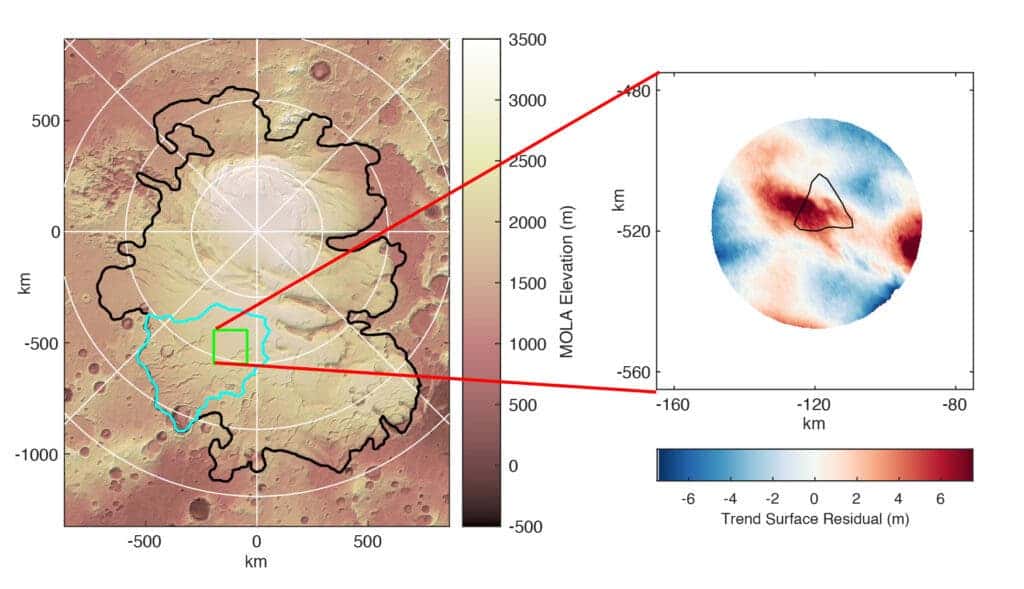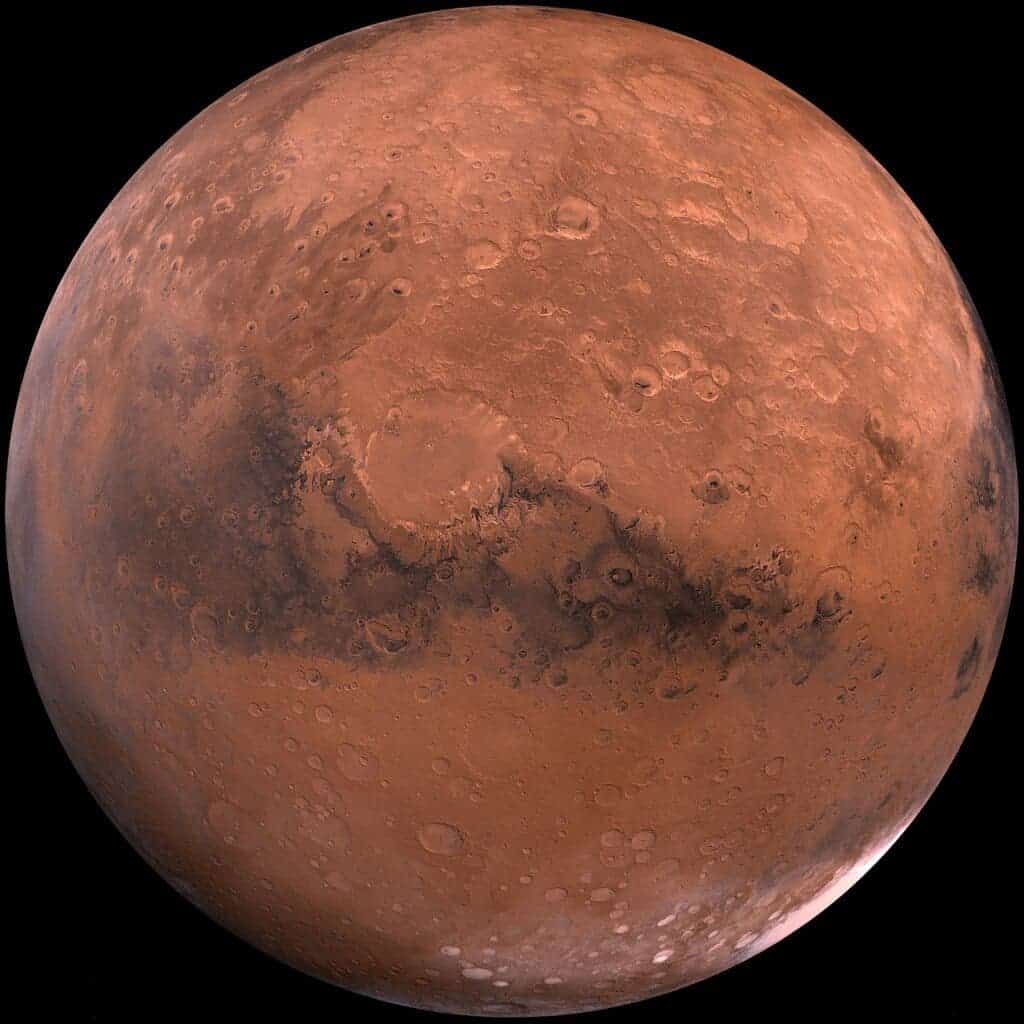Water on Mars. It’s always been debated back and forth from the 18th century to the present day. Currently, the debates have shifted south, with tantalizing evidence pointing to the presence of water under Mars’ southern pole — a claim that is hotly debated among researchers. Now an international team headed by the University of Cambridge sheds new light on the matter, suggesting that there may be liquid water on Mars after all.
We already know that there’s frozen water on Mars. Like the Earth, Mars has frozen water on its poles — but liquid water is a completely different thing.
To find subtle patterns in the height of the ice cap that could be indicative of liquid water, the researchers measured the shape of the upper surface of the ice cap using laser-altimeter measurements from spacecraft. Aftwards, they demonstrated how these patterns corresponded to computer predictions of the effects that a body of water beneath the ice cap would have on the surface.
Basically, the geometry of the ice fits exactly what you’d expect if it had water beneath it. Their findings back up earlier ice-penetrating radar measurements, which were initially interpreted to indicate the possibility of a liquid water area beneath the ice.
But that’s not exactly enough to prove that it does exist. There’s also a lot of disagreement regarding the interpretation of the radar data, with some studies arguing that the radar signal is not caused by liquid water but rather by clay minerals.
Now these new findings, published in the journal Nature Astronomy, offer the first line of independent line of evidence that liquid water may existe beneath Mars’ south polar ice cap using information other than radar — although it’s still indirect evidence.
“The combination of the new topographic evidence, our computer model results, and the radar data make it much more likely that at least one area of subglacial liquid water exists on Mars today, and that Mars must still be geothermally active in order to keep the water beneath the ice cap liquid,” said Neil Arnold from Cambridge’s Scott Polar Research Institute, who led the research.
A radar debate

At its poles, Mars has thick water ice caps similar to those on Earth that are roughly equal in volume to the Greenland Ice Sheet. The polar ice caps on Mars, on the other hand, have until recently been thought to be frozen solid all the way to their beds due to the cold Martian climate, unlike Earth’s ice sheets, which are underlain by water-filled channels and even large subglacial lakes.
In 2018, data from the Mars Express satellite of the European Space Agency called into question this presumption. The satellite has a MARSIS (Mars Advanced Radar for Subsurface and Ionosphere Sounding) ice-penetrating radar that can see through the southern ice cap of Mars. It showed a region at the bottom of the ice that strongly reflected the radar signal, which was taken to mean that there was liquid water there beneath the ice cap.
Later research claimed that other dry substances that are present elsewhere on Mars might also reflect light in a similar manner if they are present beneath the ice cap. Given the frigid climate, liquid water beneath the ice cap would need a different heat source, such as geothermal heat from within the planet, at temperatures higher than those anticipated for the Martian climate at the time.
A recent study out of Cornell University published Sept. 26 in Nature Astronomy says that any bright reflections detected beneath the surface of the Red Planet’s South Pole Layered Deposit (SPLD), could also just be regular rock. The interpretation is technical and hard to reach a clear conclusion, which is why any additional information is more than welcome.
According to the new analysis, geological layering could have also produced the brightly shining radar signal that was thought to represent underground water on the red planet. Although it’s not a given, it does imply that more convincing evidence is required before we can say for sure what lurks beneath.
“Here we demonstrate that similar reflections can be generated as the natural result of thin layer interference, without invoking any liquid water or otherwise rare materials,” write the team of researchers led by astronomer Dan Lalich of Cornell. “This result, combined with other recent work, calls into question the likelihood of finding liquid water below the south polar layered deposit.”
Lakes under ice
On Earth, subglacial lakes have an impact on the surface topography of the ice sheet that lies above them. Ice flow under gravity is influenced by the water in subglacial lakes because it reduces friction between the ice sheet and its bed. The shape of the ice sheet surface above the lake is subsequently impacted by this, frequently resulting in a depression followed by a raised area further down-flow.
The Cambridge team investigated whether liquid water at the bed of the ice could account for the observed undulation on its surface. They performed ice flow computer simulations that were tailored to the unique Martian environment. They then inserted a patch of reduced bed friction in the simulated ice sheet bed where water, if present, would allow the ice to slide and speed up. The amount of geothermal heat emanating from within the planet was also altered. These experiments produced undulations on the simulated ice surface that resembled the ones the team saw on the actual ice cap surface in terms of size and shape.
The similarity between the model-produced topographic undulation and the actual spacecraft observations, together with the earlier ice-penetrating radar evidence suggests that there is most likely an accumulation of liquid water beneath Mars’ south polar ice cap, and that magmatic activity occurred relatively recently in the subsurface of Mars to enable the enhanced geothermal heating needed to keep the water in a liquid state.
“The quality of data coming back from Mars, from orbital satellites as well as from the landers, is such that we can use it answer really difficult questions about conditions on, and even under the planet’s surface, using the same techniques we also use on Earth,” said Arnold of the Cambridge study. “It’s exciting to use these techniques to find out things about planets other than our own.”










